
Wolf spiders are members of the family Lycosidae, named for their robust and agile hunting skills and excellent eyesight. They live mostly in solitude, hunt alone, and usually do not spin webs. Some are opportunistic hunters, pouncing upon prey as they find it or chasing it over short distances; others wait for passing prey in or near the mouth of a burrow. Wolf spiders resemble nursery web spiders, but wolf spiders carry their egg sacs by attaching them to their spinnerets, while the Pisauridae carry their egg sacs with their chelicerae and pedipalps. Two of the wolf spider's eight eyes are large and prominent; this distinguishes them from nursery web spiders, whose eyes are all of roughly equal size. This can also help distinguish them from the similar-looking grass spiders.
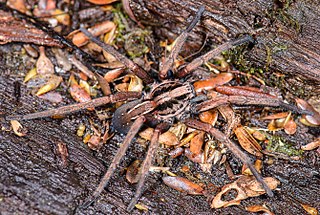
Miturgidae is a family of araneomorph spiders that includes nearly 170 species in 29 genera worldwide. First described by Eugène Simon in 1886, it has been substantially revised, and includes the previous family Zoridae as a synonym, and excludes the family Xenoctenidae. Several genera have also been removed, such as the large genus Cheiracanthium, which was transferred to the Cheiracanthiidae.

Hexathelidae is a family of mygalomorph spiders. It is one of a number of families and genera of spiders known as tunnelweb or funnel-web spiders. In 2018, the family was substantially reduced in size by genera being moved to three separate families: Atracidae, Macrothelidae and Porrhothelidae.
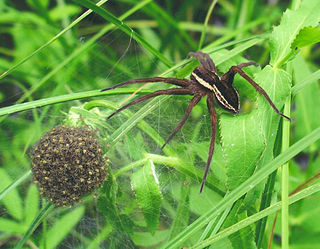
Dolomedes is a genus of large spiders of the family Pisauridae. They are also known as fishing spiders, raft spiders, dock spiders or wharf spiders. Almost all Dolomedes species are semiaquatic, with the exception of the tree-dwelling D. albineus of the southeastern United States. Many species have a striking pale stripe down each side of the body.

Hogna is a genus of wolf spiders with more than 200 described species. It is found on all continents except Antarctica.
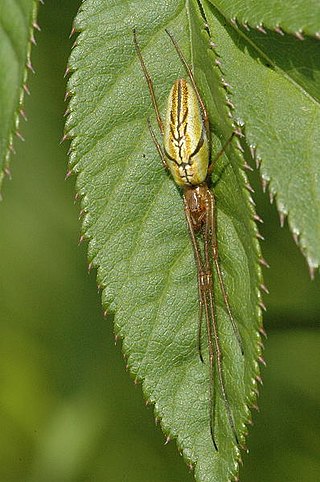
Tetragnatha is a genus of long-jawed orb-weavers found all over the world. It was first described by Pierre André Latreille in 1804, and it contains hundreds of species. Most occur in the tropics and subtropics, and many can run over water. They are commonly called stretch spiders in reference to their elongated body form and their ability to hide on blades of grass or similar elongated substrates by stretching their front legs forward and the others behind them. The name Tetragnatha is derived from Greek, tetra- a numerical prefix referring to four and gnatha meaning jaw. Evolution to cursorial behavior occurred long ago in a few different species, the most studied being those found on the Hawaiian islands. One of the biggest and most common species is T. extensa, which has a holarctic distribution. It can be found near lakes, river banks or swamps. Large numbers of individuals can often be found in reeds, tall grass, and around minor trees and shrubs.

The Artoriinae are a subfamily of wolf spiders. The monophyly of the subfamily has been confirmed in a molecular phylogenetic study, although the relationships among the subfamilies was shown to be less certain.

Dolomedes aquaticus is a species of fishing spider that lives and hunts along the gravel banks of unforested New Zealand rivers. It prefer open riverbanks where it typically lives under rocks, usually less than 5 metres away from the river. Its colouring allows it to camouflage against river stones. Normally nocturnal, it will sit and wait for prey after dark, and can survive for short periods under the water.

Cambridgea is a spider genus in the family Desidae and some of the first endemic spiders described from New Zealand. They are known for constructing large horizontal sheet webs measuring up to a square metre in larger species. Cambridgea were originally assigned to the Agelenidae by Dalmas in 1917 but were reassigned to the Stiphidiidae in 1973. Most recently, both Cambridgea and sister genus Nanocambridgea were reassigned to the Desidae, subfamily Porteriinae on the basis of molecular evidence.

Anoteropsis aerescens is a species of wolf spiders that is endemic to New Zealand.

Argoctenus is a genus of South Pacific long-legged sac spiders first described by Ludwig Carl Christian Koch in 1878. They are found in Australia, New Zealand, and New Guinea. They resemble wolf spiders except for the narrowed carapace and the eye arrangement.

Cycloctenus is a genus of Australasian araneomorph spiders in the family Cycloctenidae, first described by L. Koch in 1878. Originally placed with the nursery web spiders, it was transferred to the family Toxopidae because of the distinctive arrangement of its eyes, particularly the enlarged posterolateral eyes. It was moved to the Cycloctenidae in 1967.
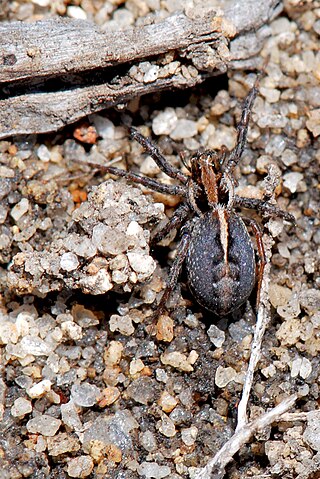
Artoria is a genus of spiders in the family Lycosidae. It was first described in 1877 by Tamerlan Thorell, and the type species is Artoria parvula. In 1960, Roewer erected the genera Artoriella and Trabeola. However, in 2002, Volker Framenau reviewed Artoria and synonymised both these genera with Artoria.

Venatrix is a genus of wolf spiders first described by Carl Friedrich Roewer in 1960.

Anoteropsis litoralis is a species of wolf spider that is endemic to New Zealand.

Anoteropsis hilaris, commonly referred as the garden wolf spider or the grey wolf spider, is a species of wolf spider that is endemic to New Zealand.
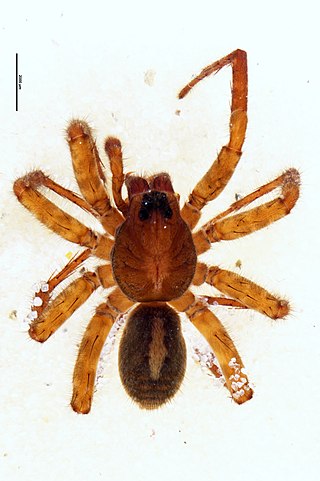
Anoteropsis cantuaria is a species of wolf spider that is endemic to the Canterbury Plains of New Zealand.

Anoteropsis montana is a species of wolf spider endemic to New Zealand. It was first formally named in 2002.


















